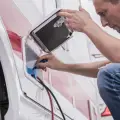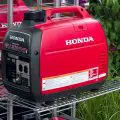Hey! This site is reader-supported and we earn commissions if you purchase products from retailers after clicking on a link from our site.
With the need for people to distance themselves from others during this current pandemic, with many RVers boondocking in remote locations, I thought now would be good time share some of my thoughts for starting and maintaining for RV’s onboard generator or a portable one if that is what you have currently.
In this article, we’ll take a look at how to start an RV generator as well as some advice for RVers on routine maintenance that you can apply very easily to keep your generator working efficiently when and if you need to use it. We’ll also look at starting procedures for your generator for those with automatic starters and those that use portable generators that aren’t installed by the manufacturer.
Finally, I’ll share some personal insight on the proper use of a generator whether you’re dry camping or at a campground with limited electrical services. While some of these thoughts will be geared toward technical issues you may encounter, others will include the proper etiquette when camping around others and using a generator.
How to start an onboard RV generator
Starting an onboard generator is a simple task, though many RV models require you to access the generator through one of your storage bay doors where the generator is located to start it running. Onboard generators are typically common to class A and C motorhomes, though I have seen many of them installed on numerous towable campers using a different fuel supply.
Generally, onboard generators are designed to run using the same fuel that powers the engine of your RV if you’re in any type of motorhome or class B conversion van. However, most towable RVs that have onboard generators are now routinely designed to accommodate those people using propane tanks because it allows them to fuel their cooking stove, furnace and refrigerator if they are properly equipped to operate those appliances at the same time using that fuel source.
With that said, onboard generators that rely upon a fuel source that is supplied through your engine fuel system are subject to safety features built into the system through the manufacturer. These include fuel distribution and most importantly exhausting the generator. Since some of these systems can fail over time, it’s important to know how they are designed and assembled.
Motorhome generators are designed to integrate the fuel used by the engine to power your rig down the road and power your onboard generator. As such, when your RV fuel tank reaches a level below one-quarter of a tank of fuel, it will stop supplying fuel to your generator.
When this happens, you’ll need to prime your generator before you attempt to start it and you’ll also need to do this if your generator hasn’t been started or run in a substantial amount of time. However, not regularly running your onboard generator can cause problems and I will address some of those issues later in this article.
Most onboard generators will have the primer button and starter button located next to each other. To prime your generator, push the prime button down 2-3 times and then hold the start button down until the engine starts. If your onboard generator won’t start after 3-4 seconds of holding the start button down, release the button and repeat the process. If you have tried this process several times and your generator is still not starting, consult your owner’s manual or consult a professional mechanic that is knowledgeable of your generator’s manufacturer and your particular model.
Some manufacturers that have onboard generators, also have automatic or remote start generators. These are not that common for the average RVer and require an additional cost when installed in your RV. However, they do allow you to start an onboard RV unit without accessing personally which appeals to many people. Personally, I would never own a unit like this because it is more costly, requires more maintenance and I would prefer to go outside to start my generator. I mean… who wouldn’t want the fresh air?
How to start a portable generator
The process for starting a portable RV generator is very similar to starting an onboard generator. The difference of course will be that you will have unload the generator from your RV, make sure it has a fuel supply and manually plug it into your RV’s power supply port.
Again, the process for how to start you RV’s generator, whether they are onboard or portable, are very similar. You’ll find that portable generators will generally be louder than onboard models so I would recommend locating them away from areas near your most commonly used living spaces such as your bedroom, living areas and places you may relax at outdoors. This is also important because of the exhaust they expel while running.
When you’re ready to start your portable generator, make sure it has plenty of fuel to run for as long as you need it to, and always check the oil level before you start the generator. Unless you have shut off your portable generator for a short amount of time to refuel it, it’s likely that you’ll need to prime it again for to start it. I recommend that you consult your operator’s manual to locate the priming button as well as familiarize yourself with some specifics such as kilowatt output and fuel usage per hour of operation on the generator that you are using.
Once you have become familiar with your manufacturer’s generator, it should become obvious that most portable generators will require you to prime the carburetor just as would do when starting an onboard generator. Since these generators very rarely have an electric or electronic ignition system, you’ll need to prime the motor and pull the recoil cord.
The recoil cord is common on push lawn mowers, outboard marine engines, portable generators, weed eaters and countless other applications when an engine has to be portable and accessed in remote locations off grid. Usually located on the side or top of your generator’s motor, you’ll find your recoil. To start your unit, prime your generator according to the manufacturer’s guide and pull the recoil cord. If it doesn’t start on the first pull, repeat the process and try again.
Generator maintenance to keep it running properly
As with any engine, it’s very important that you perform general or preventative maintenance for your generator to work properly when you need it to. I recommend running your unit 1-2 times a month, even if you are not camping where you need to use it. You should also do this when your RV is in storage if you are a part-time RVer or a seasonal camper.
One of the most important things to do whenever you start your generator, is to check the oil level. Just as important, is to change the oil as per the manufacturers recommended hours of usage. This type of maintenance would also include changing the oil filter, fuel filter, and regularly replacing the air filter as well as the spark plugs.
Proper maintenance is key, never leave a site where you have access to electricity to a boondocking site without first checking to make sure your generator is working properly. It would also be wise to do this for other components on your RV such as propane fueled refrigerators, water heaters and any other component that you’ll need to access without being connected to the grid.
Common generator issues
Most of your generator issues will directly relate to how the unit has been maintained, so it’s important to follow-up with a maintenance schedule that allows for you to run your generator occasionally and replace parts or fuel as needed. Be sure to read my guide on maintaining all essential components of your RV as well.
For example, old fuel in a generator can be a problem. It can have sediment that will clog fuel lines and fuel filters. Proper airflow through the engine is just as important. Without that, your generator engine will not fire properly just as it wouldn’t if your sparkplug or electronic ignition were not operating properly.
Also, always remember that traveling over freeways and bumpy backroads…electrical connections come loose. Always look for these issues and be prepared to deal with them when necessary.
Related: What size generator does your RV need?
So, what do I do?
I’m always aware of the area I am traveling to. For example, I test all of my components regarding my generator prior to moving to my next campsite. I make sure my refrigeration is in order as well as my furnace and air conditioning systems.
If I’m going to a campground that offers a limited power supply less than what my RV requires for 100% percent efficiency, I bring along adapters that allow me to access their power source and I cut down on my usage to prevent blown fuses or breakers.
That’s just common sense. Also, always be aware of your environmental footprint when running your RV generator. If you’re in a common campground, don’t be that guy that runs his generator at all times of the day or night. Most campgrounds have quiet hours, so be mindful of those hours so as to not disturb your fellow travelers.
I have boondocked in countless places around the United States. From the highest elevations outside of Leadville, Colorado to the lowest places such as Death Valley, California. No one wants to hear another traveler running their generator. It just spoils the experience.
Right now, traveling the globe by RV, rail, or air is being limited. Stay safe and healthy my friends and I wish you well.




